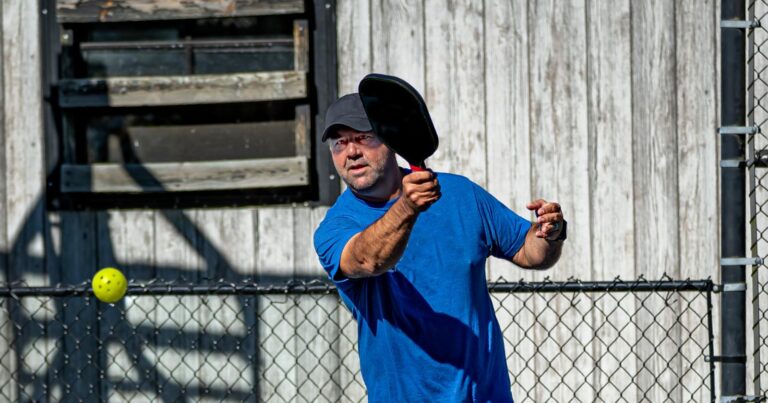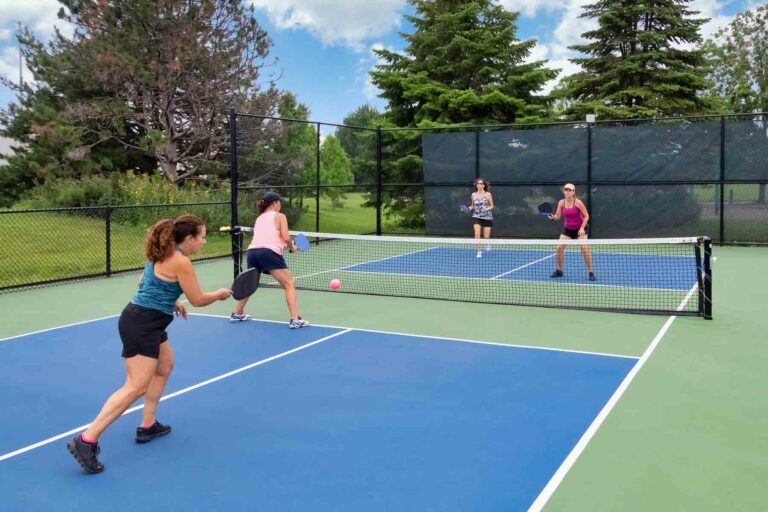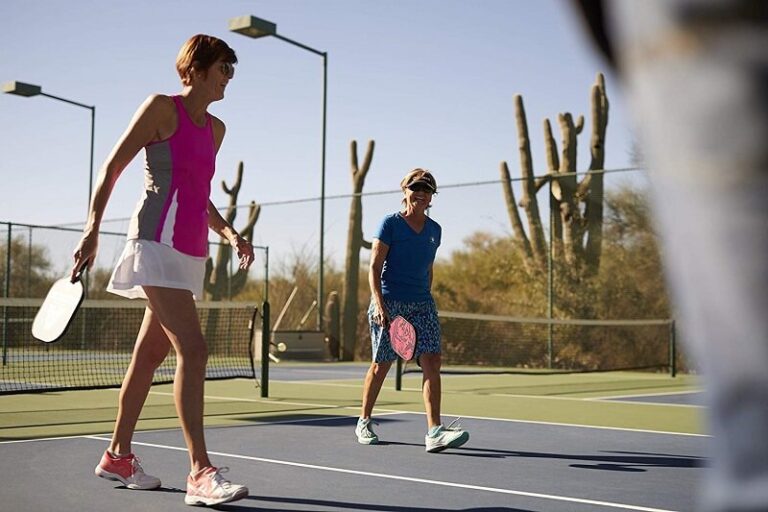How much room do you need for a pickleball court?
On your journey into the world of pickleball, one of the most fundamental questions you’ll encounter is, “How much room do you need for a pickleball court?” Understanding the space requirements is crucial, whether you’re planning to build your own court, join a local club, or simply wish to satisfy your curiosity.
To answer this question comprehensively, we mentioned the precise dimensions needed for a standard pickleball court. We’ll explore the official measurements, both for singles and doubles play, offering you a clear understanding of the space necessary to enjoy this fast-paced and highly enjoyable sport. Whether you have a vast backyard or limited space to work with, we’ll provide the insights you need to get started on your pickleball. Lets have a look!
How much room do you need for a pickleball court?
Singles Court versus Doubles Court
Pickleball courts are adaptable for both singles and doubles play. In a singles configuration, the court spans are; width-20 feet and length-44 feet. In the doubles setup spans extend to; width-22 feet, and length-44 feet. Take into account your preferences and the available space when deciding on the court configuration.
Court Boundaries
To ensure fair play, you’ll need a minimum clear space of 10 feet on each side of the court. This space ensures players can move freely and make shots without obstruction.

Singles Court versus Doubles Court
Pickleball courts are adaptable for both singles and doubles play. In a singles configuration, the court spans are; width-20 feet and length-44 feet. In the doubles setup spans extend to; width-22 feet, and length-44 feet. Take into account your preferences and the available space when deciding on the court configuration.
Overhead Clearance
Make sure there are at least 20 feet of vertical clearance above the court to accommodate high shots and lobs.
Fencing or Barrier
To prevent balls from straying, consider installing fencing or barriers around the court. This adds an additional buffer zone, making the court safer.
Surface Material
The ideal court surface is a smooth, durable, and non-slip material like asphalt or concrete. This ensures consistent ball bounce and safe gameplay.
When it comes to sports, every detail matters, and pickleball is no exception. The dimensions of a pickleball court have a significant impact on your game, determining the pace, strategy, and level of competition you’ll experience. In this article, we’ll explore how court dimensions influence your pickleball game and why understanding these factors is crucial for players of all skill levels.
Court Length and Its Effects

The length of a pickleball court, which is 44 feet in total, plays a pivotal role in shaping your gameplay.
- Serving Strategy: A longer court provides more space to serve from, allowing you to serve from different angles. It can be advantageous for serving powerful shots or placing the ball strategically to catch your opponents off guard.
- Rally Length: Longer courts typically result in longer rallies as players have more space to retrieve and return shots. Longer rallies can favor players with good stamina and consistency.
- Baseline Play: The baseline is the back boundary of the court. In a longer court, baseline play becomes more prominent, with players relying on deep shots to keep their opponents pinned at the back.
Court Width and Its Implications
The width of a court, which can fluctuate depending on singles or doubles play, impacts your positioning and movement.
- Doubles vs. Singles: A doubles court is 22 feet wide, while a singles court is 20 feet wide. Doubles courts provide more space on the sides, allowing for wider angles and teamwork, while singles courts demand more precise shots.
- Side-to-Side Movement: In a doubles court, you have more room to move laterally. It’s crucial for players to cover the court efficiently and work as a team to exploit gaps and find open spots on the court.
- Precision in Singles: In singles play, a narrower court means you need to be more precise in your shots and footwork. It’s essential to cover the court effectively and make accurate shots.
Non-Volley Zone and Its Influence
The non-volley zone, often referred to as the “kitchen,” is a seven-foot area equally along the sides of the net where players are not permitted to volley the ball.
- Strategic Challenge: The non-volley zone adds a strategic element to the game. Players need to approach the net wisely, knowing they cannot volley from this area. It encourages more well-placed groundstrokes and dinks.
- Transition Zone: The non-volley zone acts as a transition zone where players switch from baseline play to the net. Knowing how to manage this transition effectively is key to winning points.
Closing Thoughts
The question of “How Much Room Do You Need for a Pickleball Court” has been thoroughly explored throughout this article. We’ve delved into the official dimensions of pickleball courts, how these measurements impact your gameplay, and even provided insights on adapting to limited space with mini-courts. Understanding the space requirements for pickleball is the first step in embracing this exciting sport.
Whether you have a spacious area for a full-sized court or you’re working with limited space, we’ve equipped you with the knowledge to embark on your pickleball journey with confidence. So, no matter the space you have available, you can serve up some pickleball fun and enjoy the game to its fullest.
FAQs
Do I need the exact court dimensions for casual play in my backyard?
While precise dimensions are not always necessary for recreational play, it’s recommended to have a court as close to the official measurements as possible to ensure a fair and enjoyable game.
Can I adapt pickleball to limited space?
Absolutely, you can adapt pickleball to limited space using mini-courts. These scaled-down versions allow you to enjoy the game in smaller areas like driveways or backyards.
How do mini-courts work, and what are their dimensions?
Mini-courts are modified pickleball courts that can fit into smaller spaces. They are typically around 20 feet long and 10 feet wide, which is half the size of a standard court.
What is the impact of court dimensions on gameplay?
Court dimensions have a significant impact on gameplay. They determine the distance players need to cover, affecting the pace, strategy, and positioning in the game. Smaller courts tend to lead to quicker and more intense rallies.
What materials are suitable for building a pickleball court?
A pickleball court can be constructed using a variety of materials, including asphalt, concrete, or even specialized pickleball court surfaces. The choice depends on your budget and long-term plans.
What’s the ideal court surface for outdoor pickleball courts?
For outdoor courts, asphalt is a popular choice due to its durability and cost-effectiveness. It provides a smooth and consistent playing surface.
What’s the difference between singles and doubles court dimensions?
The main difference is in the length of the court. Doubles courts are 44 feet long, while singles courts are half that length, at 22 feet.
Can you play pickleball in a gym or indoor space?
Indeed, indoor pickleball is common, and many recreational facilities offer indoor courts. The court dimensions remain the same for indoor and outdoor play.
What are some basic tips for setting up a mini-court in a limited space?
When creating a mini-court, ensure it’s proportionate, mark the court boundaries accurately, and follow the net height regulations. Additionally, consider using portable nets for flexibility.
Can pickleball courts be shared with other sports like tennis or badminton?
Sure, pickleball courts can often be adapted for use in other sports like tennis and badminton by adjusting the net height and court lines.
What is the standard color scheme for pickleball court lines and the net?
The standard colors for pickleball court lines are white or yellow, and the net is typically black or dark green. However, the colors may vary depending on local regulations and court surface materials.
For the latest updates follow us on Google News:








3 Comments
Comments are closed.